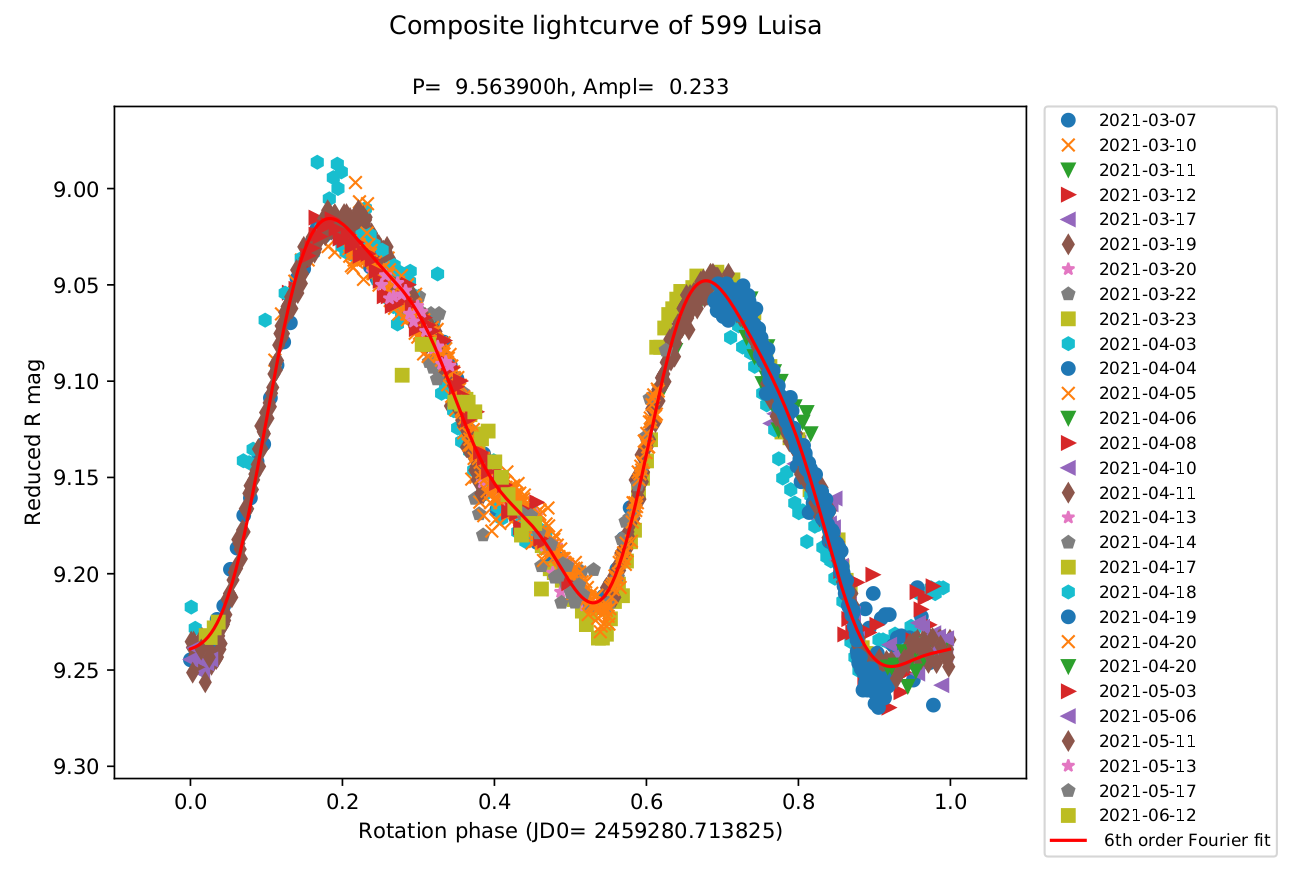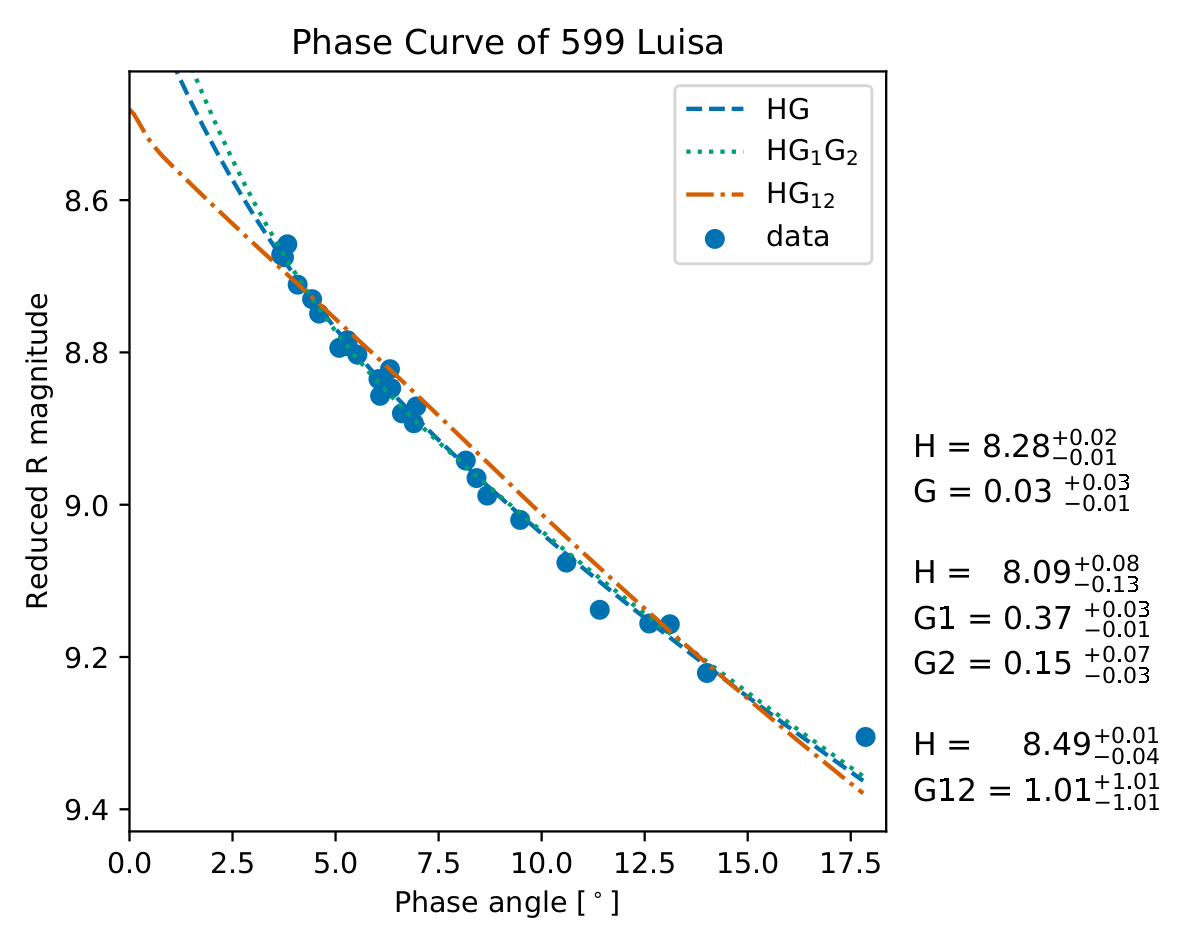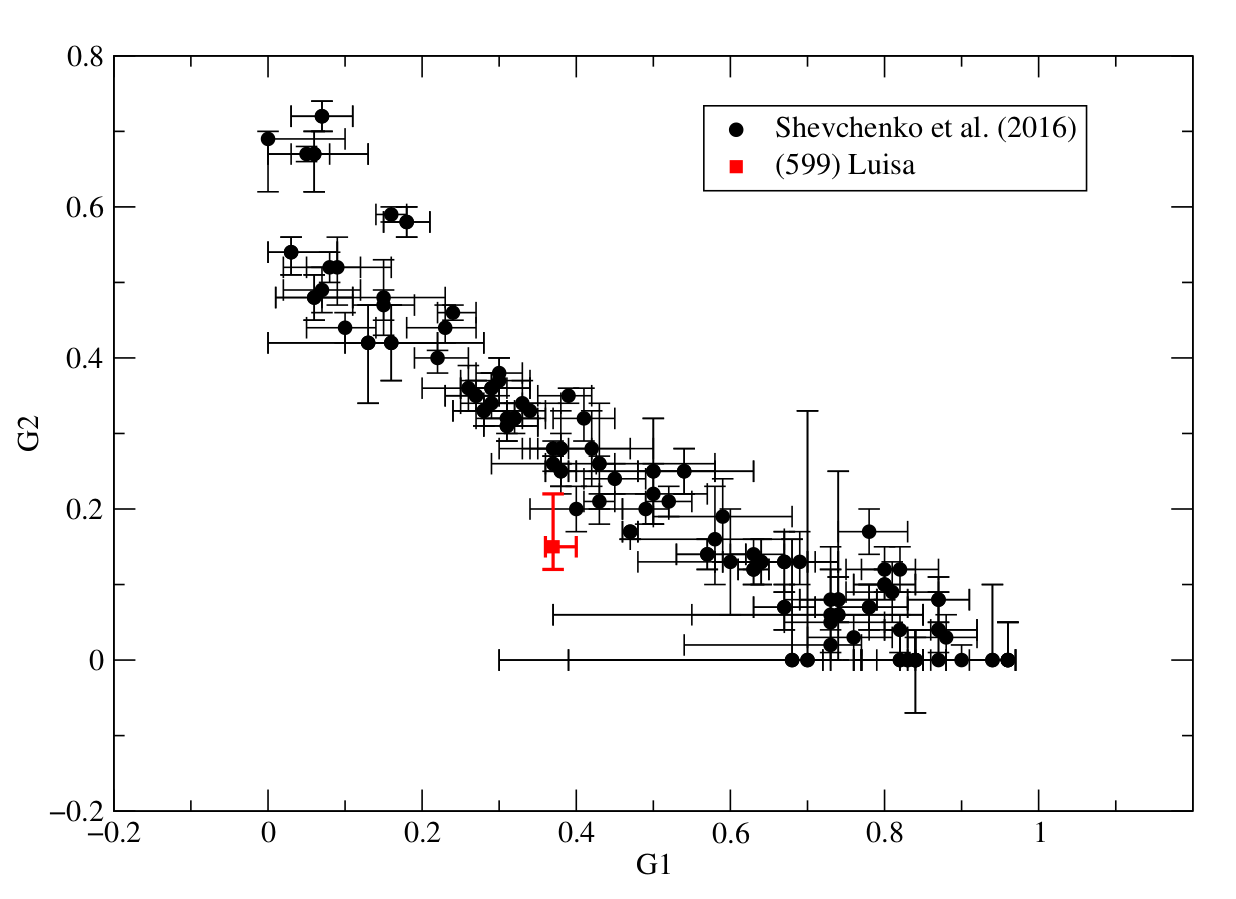Magnitude-phase curve of (599) Luisa, a Barbarian asteroid
- 1Adam Mickiewicz University, Faculty of Physics, Poznan, Poland (s.mykhailova@astron.kharkov.ua)
- 2V.N. Karazin Kharkiv National University, Faculty of Physics, Kharkiv, Ukraine (s.mykhailova@astron.kharkov.ua)
INTRODUCTION
Barbarian asteroids are a group of objects belonging to the inner part of the Main Belt. It consists mainly of L-type asteroids based on SMASS spectra [1]. Barbarians have an outstanding anomalous polarimetric behaviour, which was first observed for (234) Barbara (hence the name of the whole group). It serves as a prototype of Barbarians and demonstrates a wide negative branch of the polarisation phase curve [2]. Other members of this group show similar features. One of them – asteroid (599) Luisa – has specific to this group parameters of the polarisation phase curve αmin=14.7°, Pmin= –1.68%, αinv= 29.2° [3]. However, it appears to have atypically low-albedo, pv=0.11 [4], in comparison to other L-type asteroids, which have albedo around 0.20.
Since the polarimetric phase curves are often connected to magnitude phase curves, we decided to derive such a relation for a number of Barbarians. Here we report the preliminary results for (599) Luisa based only on the data collected with one telescope. Final results, derived with the whole data set, will be presented at the conference.
OBSERVATIONS & REDUCTION
We observed (599) Luisa during its 2021 opposition with the 0.7-m Roman Baranowski Telescope (RBT/PST2) at Winer Observatory in Arizona (IAU code 648). During the time from 7 March to 12 Jun the asteroid was visible at the solar phase angles from 9.48 deg, through 3.68 deg to 17.86 deg. Some phase angles were observed before and after opposition. All CCD frames were exposed in the Johnson R filter. Aperture photometry was performed by using the Photometry Pipeline (PP) software package [5]. Results were calibrated with the solar analogue stars taken from the PanSTARRS DR1 catalogue.
RESULTS
A composite lightcurve, including all data, is presented in Fig. 1. It was obtained with the synodic period of P=9.5639 hours (the average for the whole opposition) by a standard Fourier series fit procedure. The composite lightcurve was used to correct partial lightcurves (which did not cover all rotation phases) to the same level of maximum brightness. The magnitudes of maxima of brightness from different nights were then plotted against the phase angle producing a mag-phase curve (Fig. 2).
Three different phase functions were fitted to the data: the (H,G), (H,G1,G2), and (H, G12) relations. As can be seen, the (H,G12) function does not fit the data well while the other two display good agreement. In Fig. 3 we compare the obtained G1, G2 parameters with the reference set obtained by Shevchenko et al. (2016) for 127 Main Belt asteroids. The preliminary result obtained for (599) Luisa is not statistically different from the rest of asteroids (note the big 1-sigma vertical uncertainty) . However, this can change if the remaining data are added to the fit. The final results will be presented at the conference.

Fig 1. Composite lightcurve of (599) Luisa made from all observations. The synodical period of P=9.5639 is an average from the period of three months. The R magnitude, reduced to unit distances from the asteroid and Sun, refers to the first night. The rest of the lightcurves have been shifted vertically to fit the first data set.

Fig 2. A preliminary magnitude-phase curve of (599) Luisa with three phase functions fitted to the data.

Fig. 3. A comparison of the preliminary G1,G2 coefficients of Luisa with the most accurate values obtained for other Main Belt asteroids by Shevchenko et al. (2016). The error bars denote the 1-sigma uncertainties. Their values are different because the underlying model of statistical uncertainties is not symmetric.
ACKNOWLEDGMENT
Sofiia Mykhailova is grateful to Adam Mickiewicz University in Poznań for offering her an internship.
Tomasz Kwiatkowski acknowledges support from the grant No. 2017/25/B/ST9/00740 from the National Science Centre, Poland.
REFERENCE
1) Bus, S. J., & Binzel, R. P. (2002). Phase II of the small main-belt asteroid spectroscopic survey: A feature-based taxonomy. Icarus, 158(1), 146-177.
2) Cellino, A., Belskaya, I. N., Bendjoya, P., Di Martino, M., Gil-Hutton, R., Muinonen, K., & Tedesco, E. F. (2006). The strange polarimetric behavior of Asteroid (234) Barbara. Icarus, 180(2), 565-567.
3) Lupishko, D. F., Kiselev, N. N., & Karpov, N. V. (2020). Polarimetry of the Asteroid (599) Luisa: a New Barbarian. Solar System Research, 54(1), 44-48.
4) Mainzer, A. K., Bauer, J. M., Cutri, R. M., Grav, T., Kramer, E. A., Masiero, J. R., ... & Wright, E. L. (2019). NEOWISE diameters and albedos V2. 0. NASA Planetary Data System.
5) Mommert, M. (2017). PHOTOMETRYPIPELINE: An automated pipeline for calibrated photometry. Astronomy and Computing, 18, 47-53.
6) Shevchenko, V. G., Belskaya, I. N., Muinonen, K., Penttilä, A., Krugly, Y. N., Velichko, F. P., ... & Tereschenko, I. A. (2016). Asteroid observations at low phase angles. IV. Average parameters for the new H, G1, G2 magnitude system. Planetary and Space Science, 123, 101-116.
How to cite: Mykhailova, S., Kwiatkowski, T., and Kamiński, K.: Magnitude-phase curve of (599) Luisa, a Barbarian asteroid, Europlanet Science Congress 2022, Granada, Spain, 18–23 Sep 2022, EPSC2022-959, https://doi.org/10.5194/epsc2022-959, 2022.

